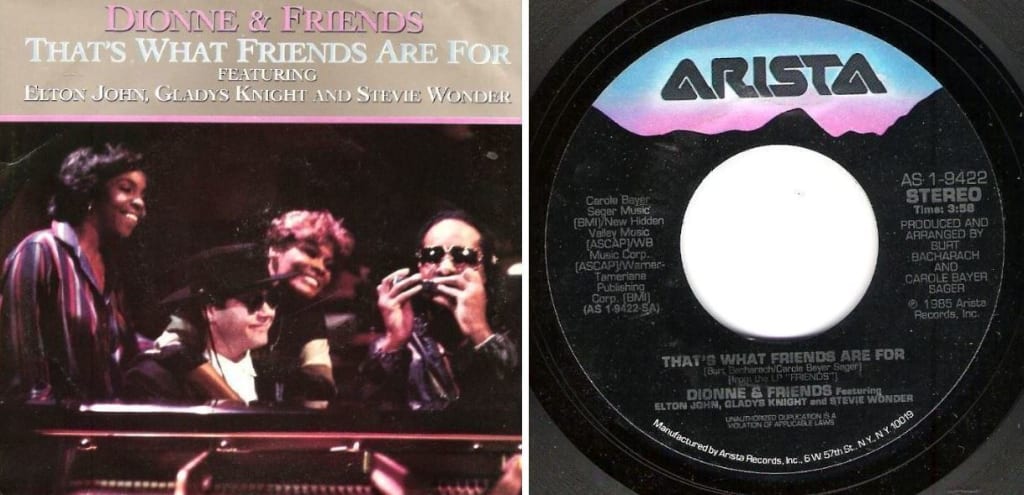By the Way, I Thank You
Life lessons from a charity single meant to save lives.

I finally took a moment to check out our favorite internet auntie’s documentary, 2023’s Dionne Warwick: Don’t Make Me Over.
It was a great watch. At 82 years old (at the time of the documentary), Dionne is still as sharp, poised, and talented as ever. It was a true joy to hear a pop music pioneer share their story with us while they’re still able.
I would suggest everyone give it a watch – it’s worth it – but there was an odd moment that had nothing to do with Dionne’s life that stuck with me.
Late in the film, Dionne visits the headquarters of amfAR, The Foundation for AIDS Research (originally known as the American Foundation for AIDS Research), in New York City. After a warm greeting from several employees, she is led into an office to chat with the current heads of the organization.
While there, Dionne reminisces about the recording of "That's What Friends Are For," the 1985 no. 1 hit that saw her sharing the mic with three other legends of music: singer-songwriter extraordinaire Stevie Wonder, soul empress Gladys Knight, and the true king of Brit-Pop, Sir Elton John.
The touching ballad, a cover of a 1982 soundtrack cut by Rod Stewart, would bring in more than $3 million for the non-profit. It would also solidify Dionne as a staunch and loving supporter of the LGBTQ+ community.
As Dionne sits on a recliner, one of the amfAR employees loads a 45-vinyl single of the song on a nearby record player. The camera then slowly zooms in on the old Arista Records logo, spinning 'round and 'round.
***********
My love of music started at a very young age. I would sneak into the living room ever so often, turn on Momma’s stereo, and turn the volume low enough for me to hear, but not her as she watched TV in the back room. I would curl up in this old, worn-down leather and wood recliner in our living room, then lean my head toward one of the tall, felt-covered speakers and just be.
It was my happy place – one of few growing up in the Bronx in the 1980s.
I had my favorites in Momma’s vinyl stack: “Thriller” by Michael Jackson. “Control,” by his sister, Janet Jackson. Whitney Houston’s album – all of it. Stevie Wonder’s “In Square Circle” album – again, all of it.
I, of course, listened to more than these, but they were my go-to records. I never felt more comforted hearing their familiar voices singing to me quietly.
My older brother, who lived with us, was also a big music lover. He was more into hip-hop, though. Hip-hop was a genre that I was far too young to understand or enjoy. I would nod along with his favorite songs to get his approval while hanging out with him, but I had never had a real connection to them (once I became an adult, things changed for the better).
On the other hand, Momma’s taste in music was way more to my liking. She enjoyed a good mix of top-40 hits and music from her childhood. There were so many times I would see her singing and dancing along, living in the moment without a care in the world. When Momma played her music, I felt warmth. It was impossible not to feel it coming through her.
I loved singing and dancing with her and, every once in a while, for her. Less on the dancing part, of course – more on the singing. I would put on my favorite songs or maybe one of hers, then lose myself in the melody and sing with every fiber of my tiny being. Half the time, I had no idea what these words meant, but I still adored the times I could be more of myself with her.
There was, however, one song Momma would play from time to time that brought out a different feeling…

According to Wikipedia, I was about four years old when "That's What Friends Are For" was released. I don’t remember much from that age. However, I remember Momma held on to the 45-vinyl single long after cassettes became the norm.
She would put the needle down slowly on the turntable, almost as if she were preparing for what was coming The moment Stevie's almost-mournful harmonica intro would kick in, her entire demeanor would shift. She would sit on the couch at the back of our living room, usually with a drink in her hand, and close her eyes. She'd still sing and nod along, but the emotion was a lot heavier.
Always being the sensitive child, I would look away and shift my focus to the record on the player. I’d lock in on the Arista logo going 'round and 'round, holding my gaze as the needle moved and skipped over the same rotations they always did.
When the song would fade, she’d always say the same thing.
"Play it again, baby. One more time.”
I never understood why she would want to stay in that experience, but I always heeded her request. I’d start the song again, Stevie would come in with his harmonica, and I’d give her a quick look before looking again at the rotating record.
After another replay or two, she would slowly stand up, walk to the kitchen to place her cup in the sink and walk to her room in silence. I wouldn’t hear a thing from her again until the following morning.
I never dared to ask Momma why the song made her feel that way or about the few times I saw her in tears while listening to it. As mature as most praised me to be at that age, it would take me until adulthood to attempt to connect the dots.
One of Momma’s very close friends – one of the first gay men I ever met – lost his fight with AIDS sometime in the early 90s. I remember his name, his voice, and his laugh. I also remember how frail he became as time went on.
He would lightly knock on our apartment door almost every night and ask if Momma was around. She often was, so he would shuffle into our apartment with his wool, royal blue housecoat and slippers, then slowly make his way to her bedroom. I never heard what they talked about, but Momma did tell me he was “sick” and that visiting her made him feel a little better.
A few years later, Momma’s older sister also died of complications from AIDS. She was the first relative after my grandmother – Nana – to pass away, and the first I remember being old enough to know what that meant. I had spent so much time with her and loved her boisterous voice and personality. She had one of the most toothy smiles I’ve ever seen, which is funny as she was missing quite a few teeth. It never stopped her from smiling, though, and it never stopped me from smiling right back at her.
The last time I saw her was at a cookout my uncle – her youngest brother – had put together. The family was so nervous before her arrival. Some questioned if she would arrive at all. When she did, everyone mentioned how happy they were to see her. She smiled back at their warm regards, but something was different. Somehow, all I could notice were the gaps in her teeth.
After a while, she grew tired of the weather and attention, so she went into my uncle’s apartment to rest. I followed suit not long after to use the bathroom. On the way out, I stopped by the living room. My aunt was there, lying on the couch while talking to Momma. I stepped up to give her a more personal hello. We chatted for a bit, falling right back into our shared comfort level. As we did, she slowly began to smile – but this time, it was the beautiful smile I knew from before. I smiled right back.

Following Don’t Make Me Over, I listened to “That’s What Friends Are For” for the first time in years. I couldn’t remember the last time I thought of the song before the documentary, but the moment Stevie’s wistful harmonica came through my soundbar, so many feelings came rushing back – along with some new ones. I’m now the one who sits back, closes my eyes, and sways to the bittersweet ballad while reminiscing about times long ago that are still crystal clear in my mind and heart.
I wish I had the foresight growing up to talk with Momma and better understand the person she was. I doubt she would’ve shared much – that wasn’t her style – but the bits she would offer could’ve opened my eyes to so much. But then again, maybe it’s a good thing I didn’t ask. There are some things in life you simply have to experience.
Funny enough, I think the song – and Momma – was trying to share that with little me all along.
"Well, you came and opened me /And now there's so much more I see /And so, by the way, I thank you.”
About the Creator
Jonathan Apollo
I bang my keyboard and words come out. Sometimes, they're worth reading. Sometimes, they're even good.
40-something, M, NYC. He/Him/His. #TPWK
https://twitter.com/JonnyAWrites
http://www.facebook.com/JonnyAWrites






Comments (2)
I love the way you weaved through memories in this. What meaningful moments you articulated, while always bringing us back to this song.
I think we all wish we had listened and learned more about our parents and grands. Being a writer gives you the opportunity to leave those stories behind for others. Enjoyed this story!